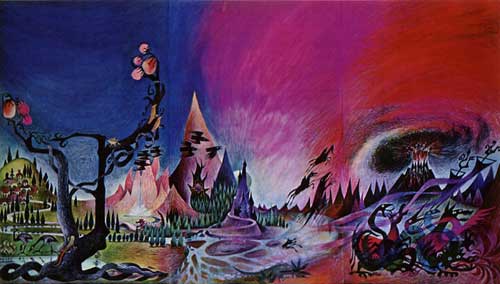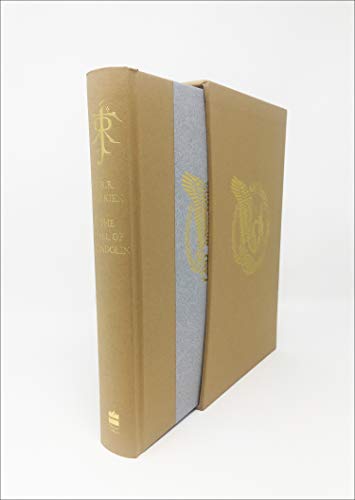Connecting with History - An Interview with Barbara Remington
This is an updated version of an interview that was originally published in Andwerve. It appears here with the permission of N Marion Hage and Andwerve.
An Interview with Barbara Remington
By N Marion Hage

Some think I need an intervention. I confess; I’m an avowed Ringnut. “What kind of nut?” you question. For the uninitiated, I’m referring to one of those odd people that love anything associated with J.R.R Tolkien’s stories about the Ring of Power. If you don’t know who Tolkien is, you might as well skip to the interview.
I’ve watched the Lord of the Rings movie at least once a month for the past three years, and read The Silmarillion from cover to cover twice. I won’t bore you further about my Tolkien book collection, because unless you’re a Ringnut like me, you won’t recognize the names.
My interview with Barbara Remington is special for a variety of reasons. If nothing else, her name is forever connected with Ring Lore, as the illustrator of the first authorized U.S paperback editions of The Hobbit, as well as all three The Lord of the Rings books for Ballantine Book Co. In this interview Barbara Remington sets the record straight concerning the unique circumstances surrounding the cover art of four of the most beloved books ever written.
Barbara is charming; a soft-spoken woman who presents as the kind of comfortably warm-soul you’d love talking with over a cup of tea. Her fascinating history unfolds one leaf at a time, and the interviewer got a sense I was standing on the edge of a treasure vault, peering at secrets known by only a few.
Where to start, and which trail do you follow with someone who has stories of famous names, places, and events all weaving together into a portrait of an artist’s life? Barbara lived in New York , and frequently visited the East Village where she had many friends at a pivotal time in history. Some would call this a turning point in U.S and world history. The Village was the East Coast’s version of San Francisco’s Haight Ashbury District, where a Bohemian subculture of artists, poets, philosophers, musicians and actors came together. Poetry readings drew big name poets and equally big-named audiences.
How I met Barbara: I teased Barbara about an incident in which she went to an art show and asked a young artist to remove his shirt in order to get a better view of his tattoos. “He’s such a handsome man, and I really loved his art work. I was also fascinated by his tattoos and asked him if he’d remove his shirt to let me take a better look. He has very nice skin color.”
I teased her, “That is just so vintage East Village. When I heard that I knew right away you were an artist.” She agreed with a laugh. This artist happened to be my twenty-four year old son, David, who introduced me to Barbara. She said, “He not only took his shirt off, which he’d hand-painted, but he gave it to me to keep and I have it hanging at home on my wall.” David and Barbara are very fond of each other. She offered him her coat in exchange for his shirt, but he refused to take it. Since then they’ve traded art through the mail.
Q: “Barbara Remington, you are so much more than an artist/illustrator, you’re a part of history. I heard you knew a number of famous names synonymous with change and innovation, and some who were linked to controversy as well.”
A: “In the sixties I lived in New York and frequented the East Village , a haven for starving artists, musicians, poets, and philosophers of that time. Such friends had a sort of professional respect for each other. We’d pass each other in the street, and recognize each other. Regardless of the kind of art, there was an acknowledgement that the other existed. I was friends with poets and musicians, not necessarily rock musicians.”
Q: “I heard you knew Timothy Leary, the famed psychedelic philosopher. What was he like?”
A: “Well, I didn’t know Timothy all that well, though I did know him. Actually, I was very good friends with his wife. Timothy didn’t really talk to me about his philosophical views. The things I remember were incidental things like him helping me sort through fabrics for the crafts I was doing.”
Q: “I also heard you were friends with the famed poet Allen Ginsberg. Were you a fan of poetry?”
A: “Yes, I love poetry. Allen was very sweet. When he would see me walking down the street, he would take my arm and guide me to wherever he was going to do a reading, and sit me in the front row. Allen always had passion in his voice when reciting his poetry. Of course most of his poetry can be described as passionate.”
Q: “Do you recall any other moments you’d like to share about Allen Ginsberg?”
A: “I remember one time where we were all in a room, Allen Ginsberg, Robert Lowell, Peter Orlovsky, and a musician friend named Denise. We were all sitting together smoking a joint, and Allen Ginsberg was quoting Bob Dylan lyrics. Right now that memory seems rather surreal, but it happened."
For those uninitiated, that was rarified poetic air. Barbara said, “I was friends with a number of famous poets. Gregory Corso and Simon Petet would stop by. I was close friends with Ira Cohen. They weren’t all friends, but most of them knew each other.”
Barbara Remington may have been most known for her cover art, but she also did work for newspapers and magazines. She did the Illustrations for the Alfred Hitchcock Mystery Magazine. She recalls, “The editor asked me to make every edition seem as if done by a different artist.” In addition she designed costumes for a number of plays at the Gateway Theatre, including for E. E. Cummings, and did window displays for Tiffany’s. She laughs, “I did window displays for Tiffany’s, but I wasn’t a starving artist. I didn’t have much money, but lived at an amazingly luxurious level. I ushered at Carnegie Hall to see free shows, and worked on a yacht to go on free trips to Martha’s Vineyard . It was a great deal of fun.”
After our wonderful stroll through the sixties, our conversation turned to the Lord of the Rings, and the cover art for books that are now etched in the fabric of history.
First, let me set one thing straight, Barbara Remington is a true Lord of the Rings fan. She’s read each book many times, and loves them all. “People wouldn’t know this; but I’ve done many sketches and illustrations related to the story, and wanted to put them in a book, but never got licensing permission.” I told Barbara there was still great interest in her art, especially related to Tolkien in today’s market. Such a book would be coveted, since many of these illustrations were her own interpretations of characters like Sauron, Saruman and Shelob, interpretations which preceded numerous now famous illustrations. “No, I have no interest in doing such a book at this point in my life,” she said. “But I do have a soft sculpture collection of LOTR characters which I’d done shortly after reading the books, which I might be interested in parting with for the right price,” she said with a laugh.
I asked about the story behind her cover art. “I worked for Ballantine, and as a practice, always read the books before doing the artwork. I didn’t have this luxury with the Tolkien Books, something I wish I could have changed. Ballantine was in a hurry to get these books out right away. When they commissioned me to do the artwork, I didn’t have the chance to see either book, though I tried to get a copy through my friends. So I didn’t know what they were about. I tried finding people that had read them, but the books were not readily available in the states, and so I had sketchy information at best.” As noted above, Barbara did make sketches relative to the books, afterwards, but she couldn’t get the publishers to see the point, something which is very regretful.
She laughs about the story behind the picture for The Hobbit which includes a Fruit Tree and Lion. She says, “When Tolkien saw the Fruit Tree, he asked, “What are pumpkins doing in a tree?" Of course they weren’t pumpkins, but he wasn’t sure what they were. I laughed, but understood he’d wanted the picture to reflect what was in his books. He was especially perplexed about the lion on the cover, because there are no lions in the story. He requested that Ballantine remove the lions from the cover, so they painted them over for later books. The earliest books were released with the lion covers.” We laughed about the collector value of the “Lion Books.”
Barbara took this all in stride. It was just how things were done at the time, and something that couldn’t be changed. “Nobody was aware of what was happening, or the magnitude of these books, or the impact they would have.”
Now, as a Tolkien fan, she says, “If I’d had the time to actually read the books first, which was my habit to do, I’d have definitely drawn different pictures. I’m a big Tolkien fan, and love these books, having read them many times. I’ve done many fantasy covers, and always read the books first.”
She says, “After reading his work, I was in awe of Tolkien. I knew there was something special about him. If I read The Lord of the Rings first, I don’t think I could have drawn the cover art.”
“Why not?” I asked in curiosity.
“I’d have felt intimidated. These books were so special, I would have perhaps felt overwhelmed,” she said, speaking of J.R.R Tolkien with utmost fondness.
Barbara explained the craziness surrounding the release of the Lord of the Rings books. “Ace books released an unauthorized edition of The Fellowship of the Ring, without Tolkien’s permission. There were some questionable copy laws that weren’t universally accepted. Ballantine bought the rights to the three books from Tolkien, and wanted to beat Ace before they had a chance to release the second two books of the series. So Ballantine authorized the release of all three books at once. This was unheard of. They came to me saying, “We want you to draw all three cover pictures now.” And this was sight unseen.”
She was put back in the same place she had been with The Hobbit, having the pressure to draw blind without seeing either book, “There wasn’t any time. They wanted them right away, and I had to draw all the covers at once.”
Barbara shared this little secret. “If you look at the art of the three books it’s really one big picture. Hold the covers next to each other, and fold them back just so, and you’ll see.”
“You didn’t draw three separate pictures?”
“No, it was one picture which was divided and used for the three books.”
I mention how such news might drive up the value of these books on EBay? We shared a laugh.





 120
120 38.82K
38.82K